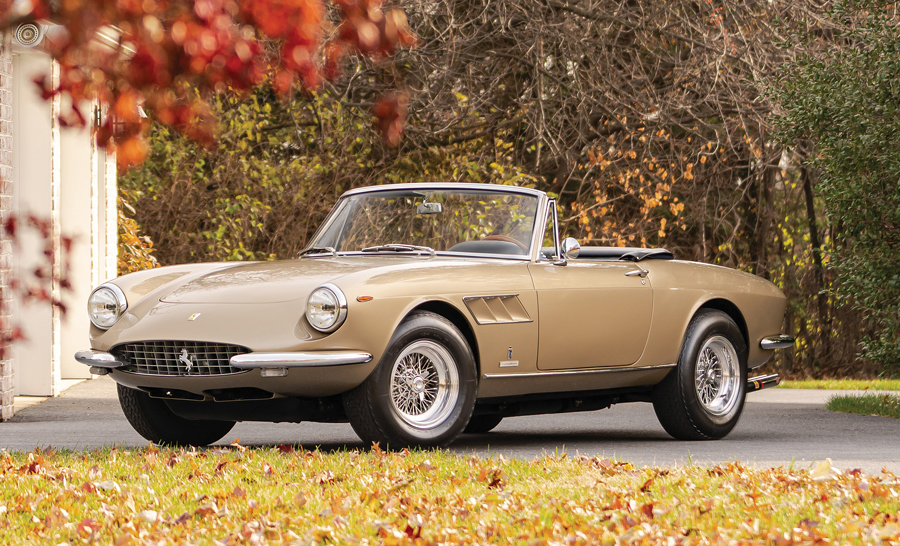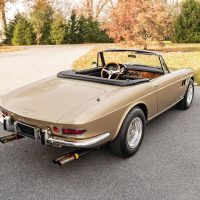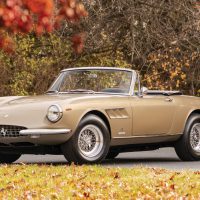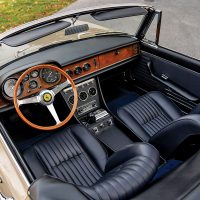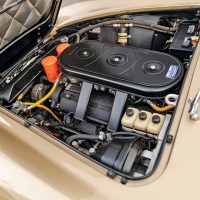SCM Analysis
Detailing
| Vehicle: | 1967 Ferrari 330 GTS |
| Years Produced: | 1966–68 |
| Number Produced: | 100 |
| Original List Price: | $16,800 |
| SCM Valuation: | $2,012,500 |
| Tune Up Cost: | $3,500 |
| Chassis Number Location: | Left frame member by the steering box |
| Engine Number Location: | Right rear above motor mount |
| Club Info: | Ferrari Club of America |
| Website: | http://www.ferrariclubofamerica.org |
| Alternatives: | 1965 Aston Martin DB5 DHC, 1965 Ferrari 330 GTC, 1967 Jaguar E-type |
| Investment Grade: | B |
This car, Lot 153, sold for $1,475,000, including buyer’s premium, at Bonhams’ Amelia Island, FL, auction on March 5, 2020.
I have a gripe with new Ferraris. They are astonishingly fast, less expensive to maintain than past models, and wonderful to drive, but they are not distinctive.
Whether by aerodynamic needs or current design trends, many modern Ferrari models look like a lot of other cars. In Ferrari’s defense, that may be because other cars now look like Ferraris, but put an NSX, McLaren, Lamborghini, Ferrari, and a new Corvette a half a block down the street and you might not be able to tell which was the Ferrari.
Pininfarina-designed, Enzo-era Ferraris were always distinctive.
You cannot name another car that looks like a 275 GTB, a 250 Lusso or a 250 GT California Spyder. Different Ferrari models may share similar taillights, similar grilles and the trademark Pininfarina compound curves, but each model was distinctive.
The 330 GTS falls firmly in the Enzo era, and along with the 330 GTC, is among the most distinctive of all Ferrari production models. No other cars look like these cars.
An elegant coupe
1966 saw the introduction of the 330 GTC. The GTC replaced Ferrari’s 250 Lusso. Pininfarina blended the rear end of a 275 GTS with the front end of a 500 Superfast to style the 330 GTC. The result was an elegant coupe with a spacious and airy cockpit. The GTC showed the owner’s good taste, complementing the driver rather than defining them.
Ferrari historian and enthusiast Dyke Ridgley wrote in Cavallino magazine that the 330 GTC was the first modern Ferrari. He argued that the 330 GTC offered the superior performance, suspension, drivability and comfort that we expect today. He offered that the 330 GTC could be driven in traffic without overheating, and, with optional air conditioning, keep the occupants in reasonable comfort.
The 330 GTC and GTS engine is an evolution of Ferrari’s legendary Lampredi V12. The 300-hp 4-liter is long on torque and quick on response. It has single overhead cams and three 2-barrel Weber carburetors. Modern valve-stem seals eliminate the exhaust smoke that plagued earlier Ferrari engines.
Hello, GTS
As a complement to the GTC, Ferrari also offered the open-top 330 GTS. The GTS was nearly identical to the coupe except for the roof. The GTS had a collapsible cloth top that was manually retracted with minimal effort and neatly stored under a vinyl upholstered fiberglass boot.
There was no pretense of the 330 GTC or GTS being a street version of a Ferrari race car — nor were they used in competition. They were intended for nothing other than luxurious high-performance transportation.
The interiors were finished with plush wool carpeting, wood dash fascia, a wood steering wheel and wide, supple leather-upholstered bucket seats. Electric windows were standard equipment, and a liberal amount of chrome trim highlighted the interior space.
Offered as optional accessories were Borrani wire wheels, air conditioning and a radio.
Our subject car, 330 GTS 9791, has a well-documented history with no known issues. It was born gray — and then painted silver. It was recently painted again, this time a beautiful gold that Pininfarina called Oro Chiaro. Ferrari engine compartments and trunks are painted black, so nearly undetectable color changes can be made. There are no deductions for color changes in Ferrari concours rules, so contrary to most marques, there is little if any financial consequence to changing the color of a Ferrari.
One of 100
The total 330 GTS production was a scant 100 units. Few met their demise, but a couple were crashed enough for concern. A few got pretty run down, but they have always been valuable enough that they were worth restoring.
Only a couple per year change hands. Buyers cannot be too picky, as the ideal car may never come along. Buying the best available example and refurbishing it to your liking might be the only way to get your “right” car.
Bonhams’ $1,475,000 sale of our subject car was startling but not entirely unexpected.
The sale went down a couple weeks after the stock market started its huge slide — and just as the coronavirus went from being a curiosity to a pandemic. It was exactly the wrong time to be selling a million-dollar car, and the result bore that out. You would have to go back to 2013 to find a lower recorded sale.
High market for a 330 GTS was when RM snagged $2,900,000 for one at their 2014 Monte Carlo sale. The market has slowly dropped since then. In early 2020, Gooding & Company sold a 330 GTS for $1,985,000, and I suspect that is as close to $2,000,000 as we will see for a while.
The seller was an active enthusiast with an impressive collection. He shows his cars and keeps them in peak condition. The GTS was shown several times, winning a coveted Platinum Award at the Cavallino Classic Ferrari show.
SCM’s reporter on the scene at the Amelia auction called chassis 9791 a spectacular example and superbly restored. The only flaw of note was a slight misalignment of the glovebox door. That opinion was backed up with the Cavallino Platinum Award and Ferrari’s Classiche certification. A buyer would have to be lucky to find a better car.
The seller purchased his car in 2008. Accepting the bid at Bonhams had to have been a gut-checking choice. The money was well below market — but still represented a reasonable profit.
The future was very cloudy on the day of the auction and not any clearer today. Passing on the bid was not a good option. At best, it would take months to find more money. At worst, that might be the best money until another cycle comes around.
The seller made the right choice. The buyer’s fortune is to be determined. ♦
(Introductory description courtesy of Bonhams.)
